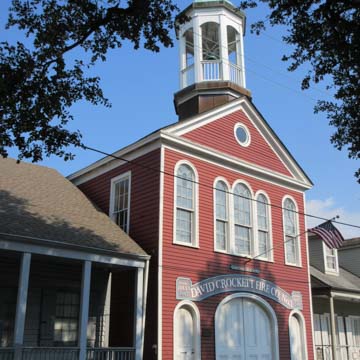In 1841, a group of local citizens formed a volunteer fire-fighting company, incorporating as the Gretna Fire Company No. 1 in 1844. The company’s name was changed in 1874 to honor David “Davy” Crockett, who was killed at the Alamo. The two-story wooden structure has a wide-arched opening on the ground floor. The front gable is finished to resemble a pediment; at its peak is a large openwork hexagonal bell tower surmounted by a small cupola. The firehouse shelters a fire engine manufactured in 1876 by the R. Gould Company of Newark, New Jersey. Weighing 3,000 pounds, it was first propelled by teams of firemen; later, when it was horse-drawn, a driver’s seat was installed at the front. The fire engine’s water pump was powered by a steam engine resting upon four wooden wagon wheels and could propel a constant stream of water to the height of a five-story building.
Next door at 201 Lafayette, the Gretna Historical Society Museum occupies the former Kitty Strehle House of c. 1845. This single-story, four-room wooden house with a front gallery supported on wooden posts is typical of the area’s early residential stock.











